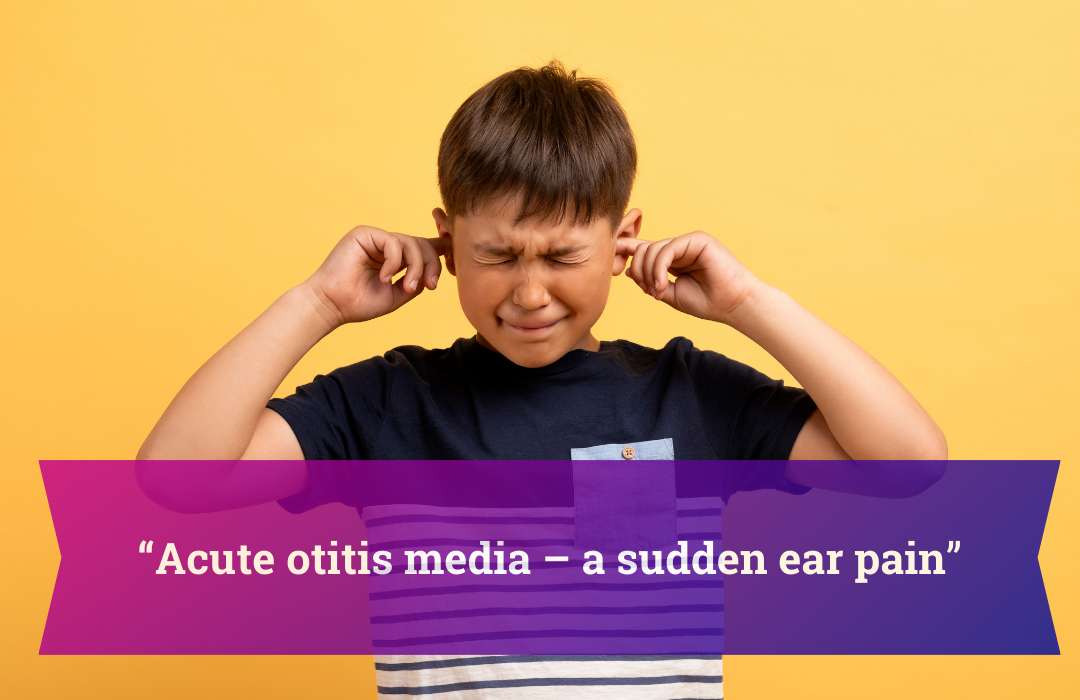Author: Dr Divya K V, MBBS MS (ENT), Senior Resident , Department of ENT & HNS, BGS Medical College & Hospital
Acute otitis media is defined as an infection of the middle ear space causing inflammation and purulent fluid accumulation usually lasting less than 3weeks. It is a spectrum of diseases that includes acute otitis media (AOM) and otitis media with effusion (OME).
Acute otitis media is the second most common Pediatric diagnosis in the emergency department, following upper respiratory infections. It is most commonly seen between the ages of 6 to 24 months.
What Causes Acute Otitis Media ?
Infection of the middle ear can be viral, bacterial, or coinfection. The most common bacterial organisms causing otitis media are Streptococcus pneumoniae, followed by non-typeable Haemophilus influenzae (NTHi) and Moraxella catarrhalis.
Viral pathogens of otitis media include the respiratory syncytial virus (RSV), coronaviruses, influenza viruses, adenoviruses, human metapneumovirus, and picornaviruses.
Risk factors
The most common risk factor is a preceding upper respiratory tract infection.
-
Decreased immunity due to human immunodeficiency virus (HIV), diabetes, and other immuno-deficiencies
-
Genetic predisposition
-
Anatomic abnormalities of the palate and tensor veli palatini
-
Improper breastfeeding techniques and lack of feeding
-
Ciliary dysfunction
-
Cochlear implants
-
Vitamin A deficiency
-
Allergies
-
Adenoid hypertrophy
-
Passive smoke exposure
-
Lower socioeconomic status
-
Family history of recurrent AOM in parents or siblings
Approximately 80% of all children will experience a case of otitis media during their lifetime.
Pathophysiology

History and diagnosis
Best indicators for acute otitis media is otalgia.
Other symptoms include
· Pulling or tugging at the ears
· Irritability
· Headache
· Disturbed or restless sleep
· Poor feeding
· Anorexia
· Vomiting
· Low grade fever
Diagnosis of otitis media is primarily based on clinical findings combined with supporting signs and symptoms as described above. No lab test or imaging is needed.
According to guidelines set forth by the American Academy of Pediatrics, evidence of moderate to severe bulging of the tympanic membrane or new onset of otorrhea not caused by otitis externa or mild tympanic membrane (TM) bulging with recent onset of ear pain or erythema is required for the diagnosis of acute otitis media.
Otoscopic examination should be the first and most convenient way of examining the ear. TM may be erythematous or normal, and there may be fluid in the middle ear space.

Testing for Acute Otitis Media
Laboratory Studies
Laboratory evaluation is rarely necessary. A full sepsis workup in infants younger than 12 weeks with fever and no obvious source other than associated acute otitis media may be necessary.
Imaging Studies
Imaging studies are not indicated unless intra-temporal or intracranial complications are a concern.
-
When an otitis media complication is suspected, computed tomography of the temporal bones may identify mastoiditis, epidural abscess, sigmoid sinus thrombophlebitis, meningitis, brain abscess, subdural abscess, ossicular disease, and cholesteatoma.
-
Magnetic resonance imaging may identify fluid collections, especially in the middle ear collections.
Tympanocentesis
used to determine the presence of middle ear fluid, followed by culture to identify pathogens.
reserved for extreme or refractory cases.
Other Tests
Tympanometry and acoustic reflectometry can be used to evaluate for middle ear effusion.
Treatment
Effective antibiotic therapy is the mainstay of treatment
High-dose amoxicillin or a second-generation cephalosporin are first-line agents
Non-steroidal anti-inflammatory drugs (NSAIDs) or acetaminophen can be used to achieve pain control.
In cases of penicillin allergy, the American Academy of Pediatrics (AAP) recommends azithromycin as a single dose of 10 mg/kg or clarithromycin (15 mg/kg per day in 2 divided doses).
Patients experienced four or more episodes of AOM in the past 1year should be considered c for myringotomy with tube (grommet) placement, according to the American Academy of Pediatrics guidelines.
Possible Complications When Diagnosed with Acute Otitis Media
-
Hearing loss (conductive and sensorineural)
-
TM perforation (acute and chronic)
-
Chronic suppurative otitis media (with or without cholesteatoma)
-
Cholesteatoma
-
Tympanosclerosis
-
Mastoiditis
-
Petrositis
-
Labyrinthitis
-
Facial paralysis
-
Cholesterol granuloma
-
Infectious eczematoid dermatitis
The conductive hearing loss resulting from chronic or recurrent OM can adversely affect language development and result in prolonged speech problems requiring speech therapy. This is one reason the American Academy of Pediatrics and the American Academy of Otolaryngology-Head & Neck Surgery recommend aggressive early treatment of recurrent AOM.
The following are the intracranial complications;
-
Meningitis
-
Subdural empyema
-
Brain abscess
-
Extradural abscess
-
Lateral sinus thrombosis
-
Otitic hydrocephalus
Conclusion
Acute otitis media is a common pediatric infection, often following a respiratory illness. Early recognition and treatment with antibiotics and pain management are key to preventing complications like hearing loss and speech delays. Preventive measures, such as vaccinations and avoiding smoke exposure, can reduce the risk of recurrence


